The 100th anniversary of the First World War is now finished but the records will continue to be preserved at the Archives and accessible to current and future generations who want to know more about the time period. In addition, this blog will remain on our website as an additional resource.
March 2018 Posts:
- 26 March: “Greatest Battle of the War now raging”
- 19 March: Cecil Bradbury: from First World War veteran to HBC employee in the Eastern Arctic
- 12 March: An Officer's View of the Great War: Francis Collinson's Scrapbook
- 5 March: Scrapbooking the First World War
26 March 2018
“Greatest Battle of the War now raging”
Lt. Col. R. M. Dennistoun (previously featured in several blogs: 8 August, 14 August 2017 and January 2018) held the position of Deputy Judge Advocate General at Canadian Expeditionary Force headquarters in London from 1917 until the end of the war and kept a diary throughout the war (and afterwards) recording his experiences of wartime in London and news about the Front.
In March 1918, one hundred years ago, he wrote of the “Greatest Battle of the War”:

Sat. 23 March 18
Greatest Battle of the War now raging. Germans have attacked in massed rushes over a 50 mile front Arras to St. Quentin.
Monday Mch. 25th
Tremendous battle. Grave situation. We are forced back to the Somme. Peronne and Ham lost. Germans claim 30,000 British prisoners and 600 guns.
Paris is being shelled by a gun 75 miles away.
Canadian Corps near Lens not engaged yet.
Intense anxiety!!
Wed. 27 Mch 1918
Germans claim to have taken 45000 British prisoners and 1000 British guns.
We have lost in 6 days at the Somme what it took us 6 months to take & still going back.
My Adjutant Capt. J. O. Slaight M. C. in todays list of killed.
Jim returns to the front today.
We dined at Naval & Military last night and went to “The Boy” at the Adelphie afterwards. It was very amusing and make us forget our weight of anxiety for the moment.
Dennistoun’s diary entries are short but capture the intensity of the time. On 2 April 1918, Dennistoun writes again of this “greatest battle” and the involvement of the Canadians and Americans:
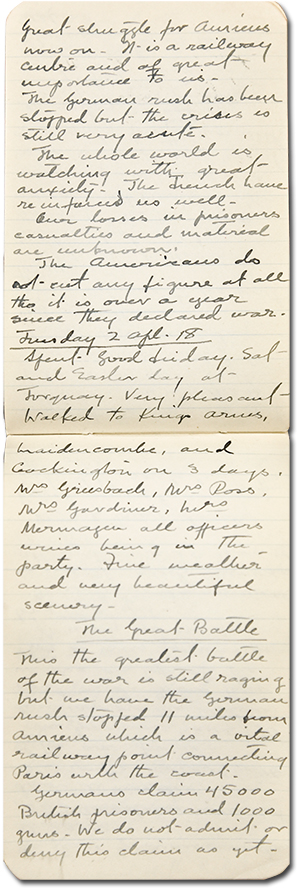
(2 images)
This the greatest battle of the war is still raging but we have the German rush stopped 11 miles from Amiens which is a vital railway point connecting Paris with the coast….Canadians doing well as usual and Americans getting their first taste of blood. We are tremendously keyed up and anxious but still confident tho the odds are against us.
Search Tip: Search “Dennistoun” in Keystone to find out more about Robert Maxwell Dennistoun and his First World War diaries.
Feedback
E-mail us at [email protected] with a comment about this blog post. Your comments may be included on this page.
19 March 2018
Cecil Bradbury: from First World War veteran to HBC employee in the Eastern Arctic
The First World War interrupted the careers of many young men, such as Cecil Bradbury. Born in 1901 in St. John's, Newfoundland, Bradbury applied to work for the Hudson’s Bay Company (HBC) at the age of 16. However, shortly after applying, he enlisted to go overseas with the Royal Newfoundland Regiment.
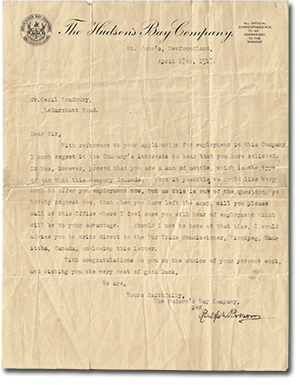
Ralph Parsons, inspecting officer for the Labrador District and fellow Newfoundlander, was impressed by Bradbury’s application. He wrote to Bradbury on 17 April 1917:
“With reference to your application for employment in this Company I much regret in the Company’s interests to hear that you have enlisted. It has, however, proved that you are a man of mettle, which is the type of man that this Company demands.”
Parsons goes on to encourage Bradbury to contact the HBC once his time in the army is finished. After the war ended, Bradbury stayed on with the occupation forces in Germany for one year. After returning home to Newfoundland, Bradbury took Parsons up on his offer and, in 1919, was hired by the Hudson’s Bay Company as a clerk posted at Lake Harbour on Baffin Island. He later worked as post manager at Frobisher Bay, Amadjuak and Arctic Bay. Between 1928 and 1930 Bradbury served on the crew of the Fort James during its aborted attempt to sail the Northwest Passage.
Bradbury left the HBC in 1930 and returned to Newfoundland. In 1933, he married Edith Gillingham and they had one daughter. Bradbury built a career with the International Power and Paper Company of Newfoundland Ltd. (later Bowater Newfoundland Pulp and Paper Mills Ltd), retiring in 1966. Cecil Bradbury died on 13 January 1996.
The Cecil Bradbury fonds contains over 500 photographs that Bradbury took during his time working in the Eastern Arctic. It also includes textual records including his journal of his experience on board the Fort James as well as personal letters, such as the one detailed above.
Search “Cecil Bradbury” in Keystone for more information about these records.
Feedback
E-mail us at [email protected] with a comment about this blog post. Your comments may be included on this page.
12 March 2018
An Officer's View of the Great War: Francis Collinson's Scrapbook
Francis Edward Collinson was born in Halifax, England on April 28, 1883. After obtaining his London matriculation in 1901, Collinson and his family moved to Manitoba around 1912 where he worked as a draughtsman and mechanical engineer for the Grand Trunk Pacific Railway. On February 19, 1916, Collinson enlisted with the Canadian Expeditionary Force. He documented his wartime experiences in his scrapbook, which covers his years of service from 1916 to 1918.
Collinson was originally with the 203rd Battalion but transferred to the 44th Battalion before being sent to Tramways Company Canadian Engineers as a Lieutenant in mid-1917. The scrapbook contains many images of his time training at Camp Hughes and in England before going to the frontlines in France. In one image, Collinson’s wife and child visited him at an officer’s training program in Camp Hughes.
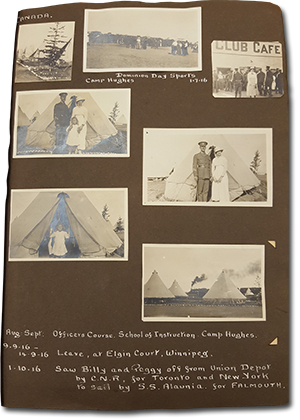
(9 images)
Francis Collinson Scrapbook: 1916-1919, July 1, 1916, P5961.
Collinson often wrote diary entries in his scrapbook noting where he went and would sometimes paste sketches and written notes about what he did during the day. In one entry, he helped prepare Christmas dinner for his men in 1917.
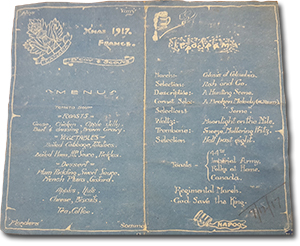
Francis Collinson Scrapbook: 1916-1919, December 1917, P5961.
As an officer, Collinson viewed several intelligence documents regarding enemy positions and movements. The scrapbook contains maps showing both German and British trench lines. In this map near Lens in March 1918, German trenches are highlighted in red while British trenches are highlighted in blue.

Francis Collinson Scrapbook: 1916-1919, March 1918, P5961.
Other intelligence documents that Collinson included in his scrapbook are captured German records, such as maps and air raid instructions.
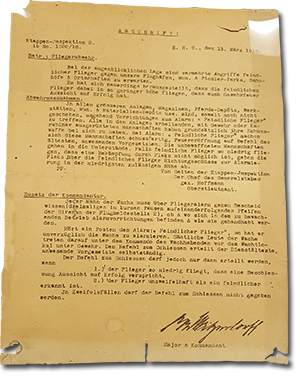
Francis Collinson Scrapbook: 1916-1919, November 1918, P5961.
After the War, Collinson continued to work at the Grand Trunk Railway and then at Canadian National Railway (CNR) until his retirement in 1948. He was active in several professional engineering associations, including the Professional Engineers Association of Manitoba and the Institute of Mechanical Engineers Canadian Advisory committee. He died in Winnipeg on April 27, 1950.
Search Tip: Search “Francis Collinson” in Keystone to find his scrapbooks and other records.
Feedback
E-mail us at [email protected] with a comment about this blog post. Your comments may be included on this page.
5 March 2018
Scrapbooking the First World War
Richard Douglas (Doug) Waugh (1893-1938), was the eldest son of Richard Deans Waugh who was mayor of Winnipeg in 1912 and 1915-1916. Early in the First World War, he enlisted with the Fort Garry Horse early and went overseas with the first contingent of the Canadian Expeditionary Force in 1914. He transferred to the Lord Strathcona's Horse in 1915 and was seriously injured that May at Festubert. He spent several months in hospital in England before he was invalided home in 1916. Waugh was employed as a purchasing agent by the Greater Winnipeg Water District following his recovery.
When he returned home in 1916, Douglas Waugh began compiling a scrapbook that he continued to work on until 1933. The scrapbook is divided into 7 sections and mainly documents the Waugh family and Douglas’s life and work until 1920 when he was married to Wilhelmina (Mina) Mowat (read about her in our 23 October 2017 blog).
The section of the scrapbook devoted to Waugh’s military service includes 47 pages of photographs, documents and accompanying captions outlining his First World War service from the time Douglas Waugh enlisted on the third day of the war in 1914 to his return to Winnipeg in 1916.
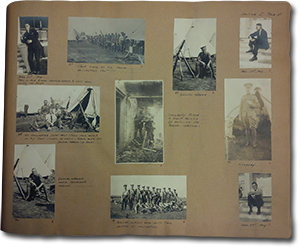
(11 images)

(10 images)
Other scrapbooks compiled by Douglas Waugh include a scrapbook documenting the First World War service of his brother Alex Waugh who died in battle in December 1917 (and was featured in our 4 December 2017 blog). Another scrapbook documents his parents’ time in Germany from 1920 to 1923 when his father, R. D. Waugh, served as a member of the Saar Valley Commission, which was mandated by the Treaty of Versailles.
Search Tip: “Waugh scrapbook” or “Waugh family” in Keystone to learn more about these scrapbooks.
Feedback
E-mail us at [email protected] with a comment about this blog post. Your comments may be included on this page.



